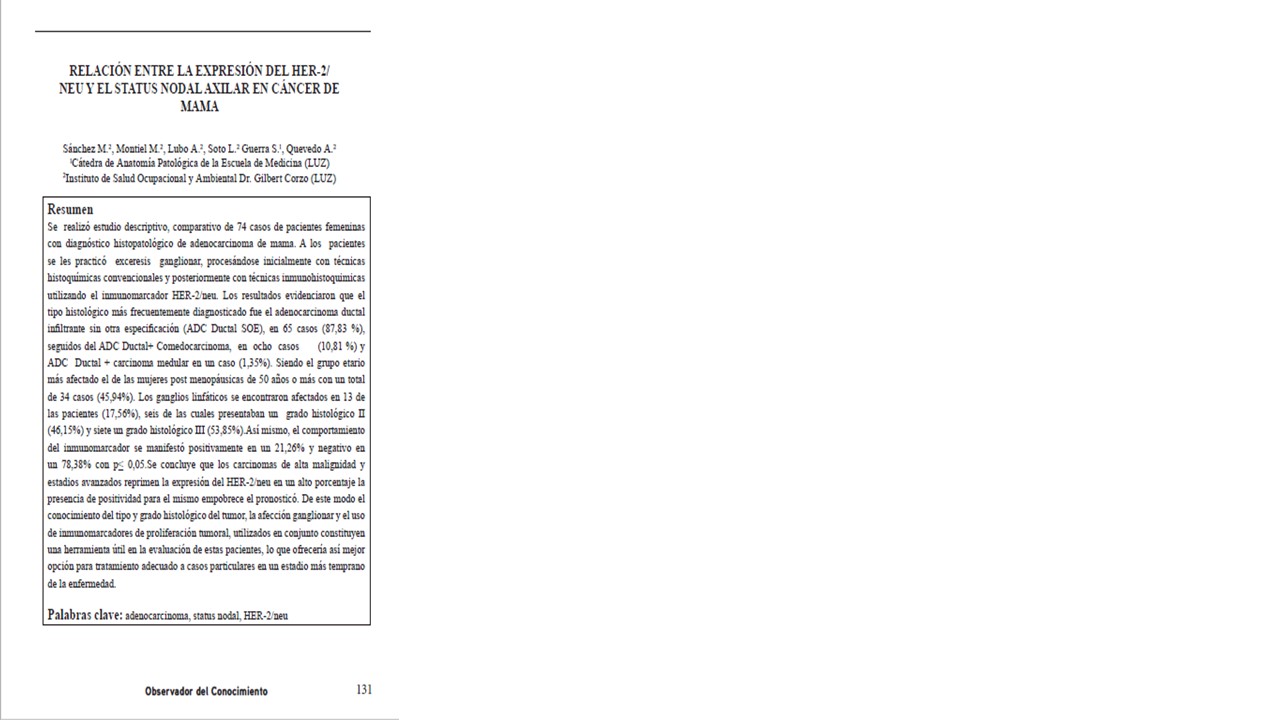Relationship Between the Expression of the HER-2 / NEU and the Status Nodal Axilar in Breast Cancer
Keywords:
Adenocarcinoma, nodal status, HER-2 / neuAbstract
Se realizó un estudio descriptivo, comparativo de 74 casos de pacientes femeninas con diagnóstico histopatológico de adenocarcinoma de mama. A los pacientes se les practicó exceresis ganglionar, procesándose inicialmente con técnicas histoquímicas convencionales y posteriormente con técnicas inmunohistoquimicas utilizando el inmunomarcador HER-2/neu. Los resultados evidenciaron que el tipo histológico más frecuentemente diagnosticado fue el adenocarcinoma ductal infiltrante sin otra especificación (ADC Ductal SOE), en 65 casos (87,83 %), seguidos del ADC Ductal+ Comedocarcinoma, en ocho casos (10,81 %) y ADC Ductal + carcinoma medular en un caso (1,35%).
Downloads
References
Baquet, C.; Commiskey, P. (2000). Socioeconomic factors and Breast Carcinoma in multicultural woman Cancer. 88(5): 1256-1264.
Bisell, M.; Weaver, V.; Lelievre, S.; Wang, F.; Peterson, O.; Schmeichel, K. (1999). Tissue structure, nuclear organization and gene expression in normal and malignant breast. Cancer Research. 59:1757-1764.
Cemiecki, B.; Schaff, A.; Callans, L.; Spitz, F.; Bedrosian, I. (1999). Inmunohistochemistry with pancy tokeratins improves the sensitivity of sentinel lymph node biopsy in patients with breast carcinoma. Cancer. 85(5): 1098-1103.
Chodosh, L.; D’Cruz, C.; Gardner, H. Ha, S.; Marquis, S. (1999) Mammary gland development reproductive history and breast cancer risk. Cancer Research. 59: 1765-1772.
Cote, RJ.; Petersen, H.; Chaiwun, B.; Gellar, RD.; Goldhirsch, A. (1999). Role of inmunohistohemical detection of lymph-node metastases in management of breast cancer. The Lancet. 354: 896- 900.
Domínguez, MA.; Marcos, M.; Meiriño, R.; Villafranca, E.; Dueñas, M.; Arias, F.; Martínez, E. (2001). Factores pronósticos y predictivos en el cáncer de mama temprano. ANALES Sis Sam Navarra. 24(1).
Dowlatshahi, K.; Fan, M.; Bloom, K.; Splita, D. (1999). Occult Metastasis in the sentinel lymph nodes of patients with early satge breast carcinoma. Cancer. 16(6): 990-996.
Gjerdrum, LM.; Sorensen, BS.; Kjeldensen, E.; Sorensen, FB.; Nexo, E.; Hamilton-Dutoit, S. (2004). Real- time quantitative PCR of microdissected paraffin-embedded breast carcinoma. An alternative method for HER2/NEU analysis. J. Mol. Diagn.6 (1):42-51.
Gonzalez- Muller, C. (2005). Características patológicas asociadas al carcinoma de mama HER-2 positivas. Anales de la Facultad de Medicina Universidad Nacional Mayor de San Marcos. 66(2):89-99.
Jemal, A.; Murray, T.; Ward, E. Cancer statistics. (2005). J. Clin. 55:10-30.
Jhonson-Thompson, M.; Guthrie, J. (2000). Ongoing research to identify environmental risk factors in breast carcinoma. Cancer. 88(5):1224-1229.
Kothari, AS.; Beechey- Newman, N.; Hamed, H.; Fentiman, D’Arrigo; Hanby, AM. (2002). Paget disease of the nipple, A multifocal manifestation of higher- risk disease. Cancer. 95:1-7.
Liberman, L. (2000). : Pathologic analysis of sentinel lymph nodes in breast carcinoma.Cancer. 88 (5): 971- 977.
Madrid, MA.; Lo, RW. (2004). Chromogenic in situ hybridization (CISH): a novel alternative in screening archival breast cancer tissue samples for HER2/NEU status. Breast Cancer Res. 6(5):593-600.
Martin, M. (2005). Anticuerpos monoclonales anti-HER2/NEU en cáncer de mama: trastuzummab. Moller del valles: Merck Oncologia, MerK farma Química.
Mestres, J.; Muñoz, M.; Gascon, P. (2004). ErbB tyrosine kinase receptor inhibitors in breat cáncer. Rev. Oncol. 6:12-21.
Montse, A.; Valero, A.; Lledo, R.; Sagales, Ll.; Carazo, A.; Cardo, C.; Torrus, X. (2005). Protocolo de estudio molecular del oncogen HER2/neu en el carcinoma de mama. Clin. Transl. Oncol. 11:504-11.
Nichols, DW.; Wolff, DJ.; Self, S. (2002). A testing algorithm for determination of HER2 status in patients with breast cancer. Ann. Clin. Lab. Sci. 32:3-11.
Pathank, D.; Osoch, J.; He, J. (2000). Breast Carcinoma Etiology. Cancer. 88(5): 1230-1238.
Reed, W.; Hannisdal, W.; Bochler, P.; Host, H.; Nasland, J. (2000). The drognostic value of p53 and c-erbB-2 inmunostaining is overrated for patients with lymph node negative breast carcinoma. Cancer. 88(4): 804-813.
Romond, EH.; Pérez, EA.; Bryant, J. (2005). Trastuzumab plus adjuvant chemotherapy for operable HER 2- positive breast cancer. N Engl. J. Med. 353:1673-1684.
Ross, JS.; Fietcher, JA.; Linette, GP.; Stec, J.; Clark, E.; Ayer, M. (2003). The Her- 2/neu gene and protein in breast cancer. Biomarker and target of terapy. Oncologist. 8: 307-25.
Wu, A. (2000). Diet and Breast carcinoma in multientnic populations. Cancer.88 (5): 1239-1244.
Zarpo, RJ.; Hammond, EH. (2002). Conference summary, strategic science simposium. HER-2/ neu testing of breast cancer patients in clinical practice. Arch. Pathol. Lab. Med. 127:549-53.

Downloads
Published
How to Cite
Issue
Section
License

This work is licensed under a Creative Commons Attribution-NoDerivatives 4.0 International License.







